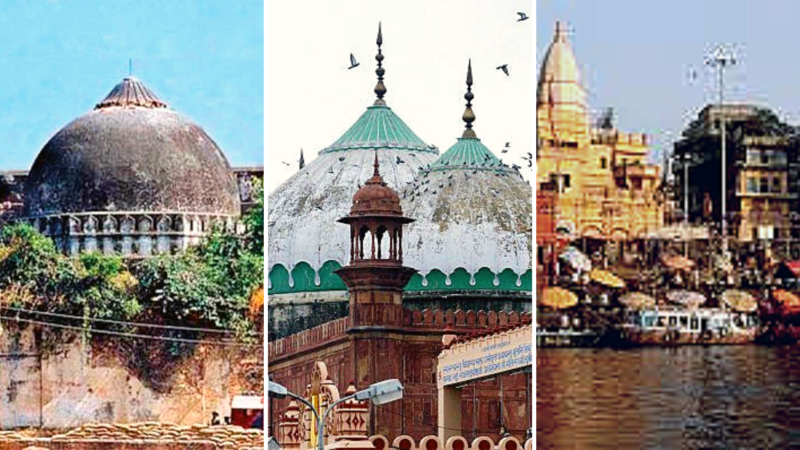GG News Bureau
New Delhi, 6th Feb. These names aren’t mere words; they hold centuries of sentiment within our society. The windows to these holy places, like Ayodhya Prasad, Mathuradas, and Kashinath, are opening once again. Who were these individuals? They were the ones who lived their lives embodying the ideals of our nation, sometimes shedding tears, sometimes smiling, but always carrying the spirit of our ancestors like a crown. These places symbolize vitality, hope for the future, and a dignified homage to our heritage.”
In Ayodhya, Ram assumed the power to calm down the violence of the demons that were creating obstacles in the Sage’s Yagyas. The tale of how to pull out Kansa’s thorn, which was infringing on everyone’s rights in the community. In addition, Kaliya Naag, who was contaminating the entire ecosystem, was killed, as depicted in the life stories of Kanha in Mathura.
Kashi, too! Here Lord Shiva is witnessed. All a person’s filth and narrow-mindedness are washed away in those tiny streets, which are resonant with the diabolical drumming. The doors to salvation are located in that city of civilizational truth.
Who then finds this fresh air problematic? Who is suffocated by eternal truth? Who is harmed by the chronicles of Ayodhya, Mathura, and Kashi? The solution that reveals the entire tale of this society’s suffering—the game of breaking it up into pieces—is obscured here. One more name is to be added to this list – Somnath!
Understanding the clash between civilizations and power dynamics will now be simpler. In the Somnath Revival Program on May 11, 1951, the nation’s first President, Dr. Rajendra Prasad, stated, “The Somnath Temple is a symbol of the fact that the power of reconstruction is always greater than the power of destruction.” However, this was the President’s view. How did the Prime Minister at the time feel about this accuracy of the statement? Jawaharlal Nehru had no wish for Dr. Rajendra Prasad to be involved in the aforementioned Somnath Temple program nor had guts to reveal the truth about history. The insistence on using the power of power to ridicule the beliefs of the society, causing the society to laugh and cry, is crucial to understanding the background of Kashi and Ayodhya and how it split Bharatiya politics.
For instance, 1949 saw the insistence on taking the idol out of Ayodhya, followed by an attempt to lock it and a false opening in 1986.
The bold declaration to replace the temple with a mosque following the disputed structure’s collapse, in spite of all the evidence being in front of them. Why did the Congress, priding itself on its lofty position, feel the need to disregard the overwhelming weight of evidence, national sentiment, and cultural norms? The Samajwadi Party’s narrative was similar. Could the killing of the kar sevaks who were chanting the name of Ram in 1990 or the cessation of worship in the Vyas basement of Kashi Gyanvapi in 1993 have been motivated by such savage and unfair political rationalization?
Leaders are incapable of leading if they do not feel the emotions of the society. Under such circumstances, the leader might seem like a shining “leader” for the family and the sycophant coterie, but all he does is cause chaos and collapse for the group.
In Bharat, the cultural understanding gap is what determines how big or small a leadership role is. If the perception of Bharat’s cultural pride was accurate, the government would have fully restored what the British and Mughals had destroyed after the country gained its independence.
On the other hand, there is a different interpretation of the tale that highlights the romantic world’s idealized portrayal of Bharat while disregarding the misery of a fractured nation. If it hadn’t been the case, Jawaharlal Nehru would have had the same grief in his eyes as Sardar Patel on November 12, 1947 (Patrick French has also brought this up as a clue). According to Dr. Rajendra Prasad, that would have been the dream. A wave of national leaders emerged, intent on restoring Somnath, the first of the twelve Jyotirlingas destroyed by Mahmud Ghaznavi, to its former glory. The other, more powerful stream paid no attention to any of this. In addition, he strongly objected to this. The future of various contemporary political currents in Bharat was determined by this difference.
One group comprises individuals who recall the most brutal and barbaric periods in history and who recognize their ancestors in their cultural heritage. Secondly, there are those who wish to deny reality by referring to the invaders as guests. These individuals fail to acknowledge the tremendous efforts made by thousands of mothers, the innocent people’s minarets, the Gurus’ sacrifices, or the coerced conversion of ancestors. However, the roar of bravery that drove out the invaders and the echo of the invaders’ laughter can both be heard in the history of the oldest civilization on Earth. Tales of Chhatrapati Shivaji Maharaj and Lokmata Ahilyabai Holkar are also told, along with tales of charlatans full of narcissism and selfishness.
Everybody witnessed the extraordinary moment of Ayodhya Ram mandir innorgration ceremony. Beyond random judgments, Hindus will undoubtedly witness Kashi’s developments progressing toward historical justice and truth once again.
This immediately brings to mind the speech Prime Minister Narendra Modi gave on August 20, 2021, at the gala event for the Somnath Temple projects. At his speech, he had mentioned Ahilyabai, saying, “Today I also pay my respects to Lokmata Ahilyabai Holkar, who renovated many temples from Vishwanath to Somnath.” As the nation moves forward, it is seen as the ideal combination of modernity and antiquity that existed during his lifetime.
Undoubtedly, efforts are being made by the nation to right historical wrongs. Now, Nandi can hear the gongs of the bells and damru and echoes of aarti done in the Vyas basement of Kashi Gyanvapi. Now, it’s time to follow the footsteps of Avimukteshwar, who gave everyone hope for salvation.


Comments are closed.